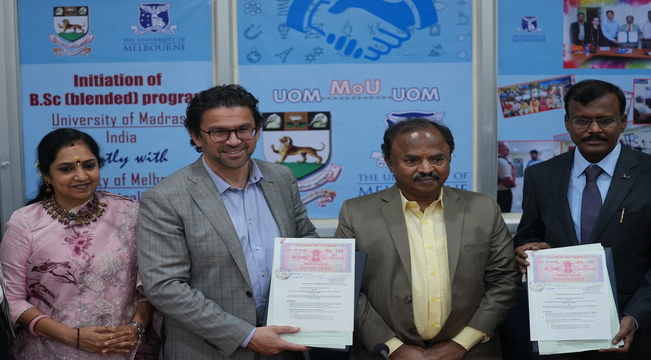By Dr. Anupam Narula is Professor of Marketing at Amity University Uttar Pradesh (AUUP), Noida
There is huge potential in the Indian higher education market, which is composed of formal regulated market of 15 billion US dollars and the informal unregulated market of vocational education and skill development of 5 billion US dollars.(Techno pack, Nielsen, JM Financials).The landscape of Indian higher education has changed over the past decade from 436 universities in 2009-10 to 993 in 2018-19 and from 26,000 higher education institutions (HEI’s) to over 50,656 in 2018-2019. Amongst these 50,656 higher education institutions (HEI’s), 39,931 are colleges which are not empowered to provide degree in its own name and therefore are affiliated/recognized with universities and 10,725 are stand-alone institutions (not affiliated with Universities) which are not empowered to provide degree and therefore run diploma level programmes. Over 40 % of theses HEI’s run only single progranmmes, out of which 83.1% are privately managed. Over 20 % of colleges have enrollment below 100, while only 4 % of colleges have enrollment over than 3000. The Post Graduate Level programmes are run at 34.9% colleges and only 2.5% colleges run Ph.D. programme. (AISHE, 2018-19, MHRD, GOI Report).This reflects fragmented nature of the higher education sector, which has literally thousands of HEIs, in the private sector particularly, with a very small number of students. This fragmentation leads to sub-optimal performance for business schools with small size and with inadequate resources. These business schools have rigid boundaries of their own disciplines and fields with authoritative work culture and lack of quality faculty for practical knowledge creation.
Do you think the small size,fragmented business-schools will exist in neat future?
As per my experience of being into this education sector for more than 24 years, this sector and especially business schools are no longer insulated from change in the business environment and society. The future of higher education will be shaped by the market mechanisms in a globalized world.The current scenario can be compared to a nonlinear dynamic system and whether this system is stable or chaotic depends upon the market variables created by the NEP 2020. The business schools have become like the chaotic environment and their systems will have to display greater agility and adaptability in terms of designing and delivering its course curriculum, bringing in new courses, developing new pedagogical tools, upgrade faculty knowledge and technological obsolescence, ensure student engagement amidst reducing consumer education life cycle, building good infrastructure and so on, in order to tackle the volatile, uncertain, complex and ambiguous (VUCA)environment. Each business school will have to define its purpose and solve the problems of their target customers/studentsby networking closely with all its stakeholders, especially the industry.
This is not a surprise that we will see the largest consolidation ever in this sector over next decade. In a 4-5% GDP growth environment it is very difficult for small players to gain market share and the stronger players will become stronger. Amongst more than 50,000 HEI’s, the smaller fragmented ones with few course providers will phase out either through merging with the large multidisciplinary institutions/universities or will shut down in a phased manner. The NEP 2020 has created‘Market’as a regulator to swiftly play its role in the higher education sector and HEI’s will be driven to expand itself into multidisciplinary universities, or cluster and consolidate themselves into viable universities. Clustering HEIs into large multidisciplinary universities will enable delivery of holistic education to students, lead to better utilization of available resources, foster operating efficiencies and reduce costs. This will fulfill the goal of policy makers to foster greater academic value proposition, enhance research and create large institution in each district by 2040, serving as a higher education “cluster” or knowledge hub.
Multidisciplinary universities need to strike a balance between learning and employment opportunities. One way to approach this is to integrate some of the key employment skills—such as problem solving, critical thinking, communication, and entrepreneurial abilities—into the course curriculum, which even premier business schools in India were not able to achieve. Not only will this help shift the focus to practical methods of learning but it can also ensure a relatively smooth transition to employment.
The consolidation trends will also impact and strengthen the rankings of universities and will be able to achieve a better competitive position of the university from the perspective of international comparisons.The advantage of international rankings is the possibility of comparing not only universities, but also countries among themselves, and tracking long-term trends in changing relative positions in the ranking scale. In the internet era it has become so important for the universities to be visible at reputed international platforms as it reflects the strong mechanism of convergence of public policy towards the higher education sector in the country. At present in the prestigious ‘Quacquarelli Symonds (QS) World University Rankings 2021’, only three Indian institutions- IIT-Mumbai, IIT-Delhi and IISc (Bengaluru)- have been included in the world’s top 200 and in the ‘Times Higher Education (THE) World University Rankings 2021’only two Indian institutions, the IISc Bengaluru) and IIT-Ropar, have been included in the world’s top 400.
This grand experiment in the education sector of India has just begun by coming of NEP 2020. Yet even at this early juncture, I feel confident that combining institutional resources to achieve synergies and scale through consolidation, while not a panacea for all, is an option that should be seriously considered by greater number of business schools that are currently recognized. Consolidations are not easy, since the structure and culture of higher education system is resistant to change, and the academic community is skeptical by nature. Only time will tell the benefits of consolidation, but when approached with selectivity, aspirational vision, strategic planning, cultural awareness, collaborative thinking, and a pioneering spirit, consolidations will not only lower costs but also deliver dramatic benefits to the entire education community within the nation and across the world.
Corp Comm India (CCI Newswire)


































